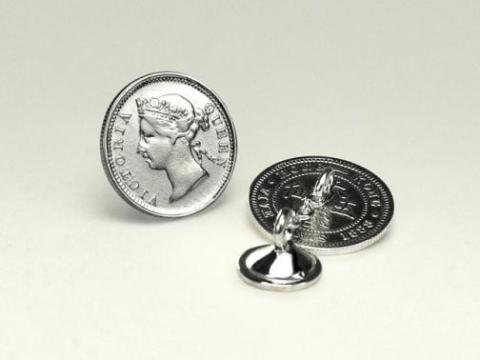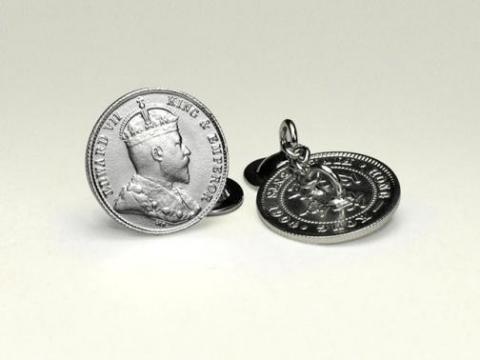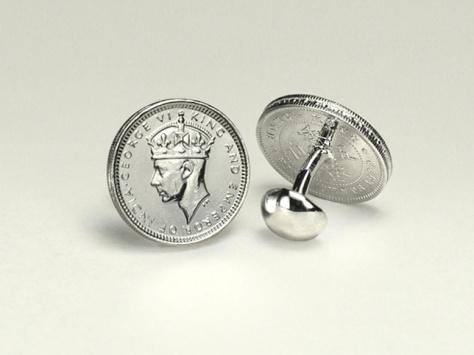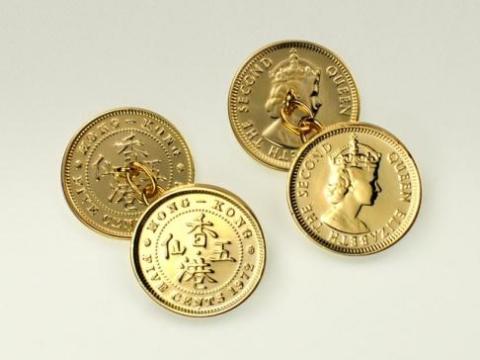A short history of the five cent coin
Primary tabs
The following guest post was written by Ben Huang.
Introduction
The five cent coin, also known as the dao ling (斗令), is an integral part of Hong Kong’s history, and was in use from as early as 1866 right up to 1980.
Different materials from silver to nickel to nickel-brass have been used for the coin which has seen all the monarchs from Queen Victoria through to Elizabeth II. Throughout this time the design of the coin has largely remained unchanged - the sovereign’s effigy is on the front of the coin and the legend ‘Hong Kong Five Cent’ in Chinese and English on the reverse. Small in size and handy to use, its longevity as well ubiquity meant that it played a big part in everyday life in Hong Kong, earning it the affectionate moniker the 'dao ling'.
A silver start
In Jan Morris’s book ‘Hong Kong’ [1], she provides a description of the colony in the 1880s, which forty years after its foundation and with the British Empire approaching the height of its power, had found its own exotic place as the easternmost of all Her Majesty’s dominions and become in British eyes The Pearl of the Orient.
In the 1880s the colony was booming – ‘we have passed through our bad times’, Jardine’s taipan told Kipling, ‘and come to the fat years’. Morris describes the place as the Compleat Colony as many of the instruments of modern life had been established - a Chamber of Commerce, the Post Office, as well as four issuing banks.
The Hong Kong Mint [2] had in fact already been set up in 1866. The first Hong Kong five cent was issued there as a silver coin of 80% fineness. However the poor reception of the coins as well as continued debasement of silver caused huge losses to the Mint which was closed less than two years later in 1868.
Subsequently it was Heaton’s Mint in Birmingham that continued to mint the 80% silver Hong Kong five cent and many of the coins carry the letter H as a mintmark.
This carried on through the reign of Edward VII (1901 to 1910) and George V (1910 to 1936) although 1933 was to be the last year the five cent was minted in 80% silver.
The switch to nickel
During George VI’s reign (1936 to 1952) the metal for the coin was changed to 100% nickel.
The 1941 issue is particularly rare – it was dispatched from the UK to Hong Kong in several shipments: one fell into Japanese hands, another was melted down by the British and a third was sunk during enemy action.
The final five cent coin, in nickel-brass
In Queen Elizabeth II’s reign the material for the coin was changed to a nickel-brass alloy.
It makes an appearance in the endearing 1966 pop song, ‘Kowloon Hong Kong’ by The Reynettes [3]:
Gong Hei, Gong Hei Fat Choi, Lai See Dao Loi, Dao Ling Mm Oi!
Congratulations and be prosperous, now give me a red envelope, but not with just a five cent inside!
By the 1960s and 70s the face value of the five cent coin had steadily declined to the extent that it was fast becoming redundant. In 1980 the coin ceased to be used as currency and was officially demonetized although there was a limited mint of non-circulating five cents in the auspicious year of 1988 which became a collector’s item.
Patinova is a company that specialises in making jewellery with cultural themes. One of its ranges is the cufflink made with the old Hong Kong five cent coin. It is a cufflink that carries a lot of history and many layers of meaning but it is small in size and remains a perfectly subtle and understated piece of jewellery. They can be seen at www.patinova.com
References:
- Hong Kong: Epilogue to an Empire, by Jan Morris
- Location & picture of the Hong Kong Mint and its dam
- The Reynettes sing 'Kowloon Hong Kong':






Comments
Re: A Short History of the 5 cents coin
Hi there,
Talking about coins, I remember there used to be the 1 cent coin as well. I remember have had had at least one such silver coin somewhere. But since childhood I had moved three times, it might take a while for me to remember where did I store it. A shame......
Best Regards,
T
one cent notes
from stuff i have read, it seems that in WW2 a ship carrying a hold of coins destined for hong kong sank en route. the bank emitted the original notes as a stop-gap measure. anyway they kept printing them as they were extremely popular for lai see, lucky money at lunar new year. myth or reality? - it is a good story though :)
Re; One Cent Note
Hi there,
The One Cent Note was printed only on one side. The back is blank. Before the Electronic age, it has its use for paying income taxes (for people who does not have a current account) as it is usually down to the very cent. I think the One Cent Note was till in use in the 1990's.
Best Regards,
T
one cent notes
I had one of these in my change once. It was some official payment - maybe terminating an electricity account and paying off the balance? That would have been some time after 1992.
It looks like I got one just in time - Wikipedia says they went out of use in 1995.
regards, David
The Five Cent Coin
The history of the five cent coin reminds me of the Chinese nickname for former Commissioner of Police, Charles Payne Sutcliffe (1969 to 1974) "Yat Ho, Dao Ling" or "Ten Cents, Five Cents" which resulted from his permanent expression:
one cent notes
my late father got into a 'between a rock and a hard place' situation over 2 cents he owed clp - they must have spent at least 50 cents with the reminders!!! my mother must have solved it as he was adamant that he wasn't sending a cheque for 2 cents :)
One Cent Notes
They were converted to amusing individual name cards by many people, the reverse being blank. They were proaably committing an offense against the currency laws of the time. OnOn.
Hong Kong Currency Exhibition 14 March - 4 June 2012
Highlights include the working dies of almost all the HK coins all the way back to the one-mil coin from 1863 as well as a coloured print of the facade of the Hong Kong Mint drawn by the architect.
A very well put together exhibition, well worth a visit! At the Hong Kong Museum of History.
I had a whole stack of these
I had a whole stack of these one cent notes as a kid and thought they were 'toy money'. I remember having had one KGVI note amongst the remaining batch of the much more common QEII variety. Now I know the KGVI one was the issue from 1945: A different design without the head of the monarch came out in 1941.
“PAPER COUPONS FOR ONE CENT TO BE ISSUED
Owing to the shortage of copper coins in the Colony paper coupons for one cent are to be issued and will be legal tender up to one dollar.
Addressing the Finance Committee yesterday afternoon, Hon. Mr N.L. Smith (Colonial Secretary) said: This day week it is proposed with the approval of the Secretary of State to take through all its stages the Bill of an Ordinance which will authorise the issue of paper coupons for one cent.
There is a great lack of copper coins in the Colony at the moment and the legislation will allow these small notes, if approved, to be legal tender up to one dollar.
The Bill will be published in the Gazette tomorrow (Friday).”
Source: Hong Kong Daily Press, page 8, 23rd May 1941
The wiki page explaining the background to this peculiar note